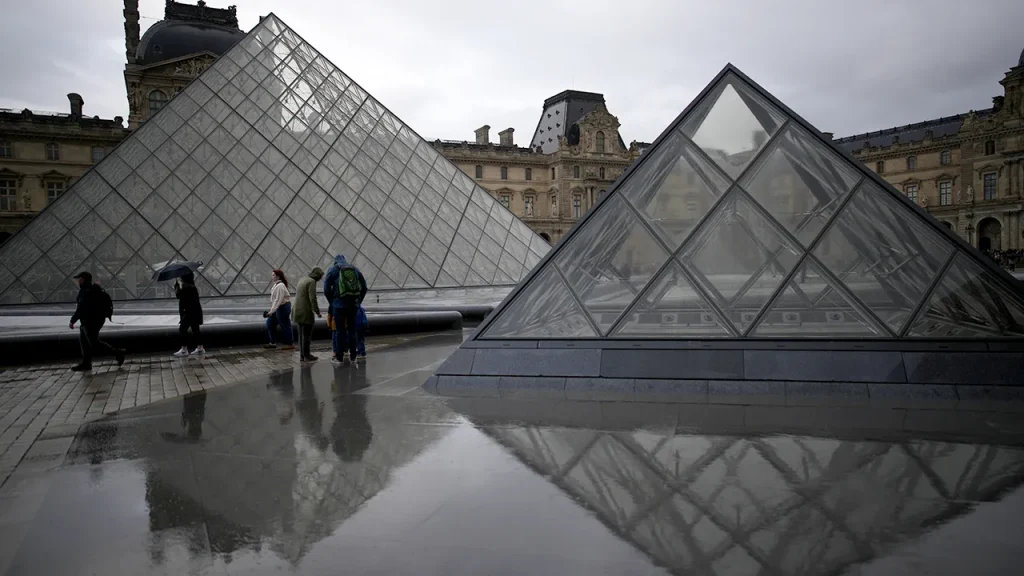Crown Jewels Heist: A Daring Daylight Robbery at the Louvre
In a stunning development that has captured international attention, French investigators announced Thursday the arrest of five additional suspects connected to the brazen theft of the French crown jewels from the Louvre Museum. This brings the total number of arrests to seven, though the priceless treasures—valued at approximately 88 million euros ($102 million)—remain missing despite extensive searches conducted overnight. The heist, which took place in broad daylight on October 19, was executed with remarkable precision, with the thieves needing less than eight minutes to make off with some of France’s most historically significant royal jewelry. Paris prosecutor Laure Beccuau revealed to RTL radio that the arrests occurred during separate operations across Paris and neighboring areas, including the Seine-Saint-Denis region, though the identities of these newest suspects have not been publicly disclosed.
The first two arrests in the case came earlier this week, with both suspects now facing preliminary charges of criminal conspiracy and organized theft. According to Beccuau, both individuals have at least partially admitted their involvement in the heist. One suspect, a 34-year-old Algerian national who has lived in France since 2010, was apprehended at Charles de Gaulle Airport while attempting to flee to Algeria on a one-way ticket. Residing in the northern Paris suburb of Aubervilliers, his criminal history included only traffic violations, but investigators recovered his DNA from a scooter used during the getaway. The second suspect, a 39-year-old with multiple previous theft convictions, was arrested at his home in Aubervilliers. Forensic evidence linked him directly to the crime scene, with his DNA found on both a display case that had held the jewels and on items abandoned by the thieves during their escape.
The robbery itself demonstrated remarkable planning and execution. The thieves used a basket lift to scale the museum’s exterior wall, forcibly opened a window, and employed cutting tools to access the display cases in the Apollo Gallery. They escaped with eight historic pieces of royal jewelry, including a sapphire diadem, necklace, and earring set associated with Queens Marie-Amélie and Hortense; an emerald necklace and earrings that belonged to Empress Marie-Louise, Napoleon’s second wife; a reliquary brooch; and Empress Eugénie’s diamond diadem and corsage-bow brooch. In what appears to be either a hurried escape or perhaps an intentional gesture, the thieves left behind Empress Eugénie’s emerald-encrusted crown—a spectacular piece containing over 1,300 diamonds—which was later discovered outside the museum in damaged but recoverable condition.
The theft has prompted serious questions about security at one of the world’s most visited and renowned museums. Louvre Director Laurence des Cars acknowledged what she described as a “terrible failure” in the institution’s security protocols, though prosecutor Beccuau has indicated there is currently no evidence suggesting the robbery was an inside job. The case highlights the ongoing vulnerability of even the most prestigious cultural institutions to determined criminals with careful planning. Security experts worldwide are likely reviewing their own measures in light of how quickly and efficiently the thieves were able to penetrate the Louvre’s defenses and make off with irreplaceable historical artifacts in the middle of the day at one of the world’s busiest museums.
The investigation now enters a critical phase as authorities work with the arrested suspects to recover the stolen items. In a direct appeal to those currently in possession of the jewels, prosecutor Beccuau emphasized that the pieces are “unsellable” due to their historical significance and international recognition. “Anyone who buys them would be guilty of concealment of stolen goods,” she warned during a public statement on Wednesday night, adding, “There’s still time to give them back.” This appeal suggests authorities may be considering potential amnesty or reduced penalties for those who facilitate the return of these national treasures, recognizing that the historical and cultural value of the items far exceeds even their substantial monetary worth.
As the investigation continues, the case evokes memories of other high-profile art and jewelry heists throughout history, where the perpetrators often discover that stealing such recognizable treasures is only the first challenge—successfully selling or ransoming them presents an entirely different set of obstacles. The French crown jewels represent not just immense material value but centuries of national history and cultural heritage. Their theft strikes at the heart of France’s royal legacy and collective memory. While the arrests mark significant progress in the investigation, the recovery of these irreplaceable historical artifacts remains the paramount concern for both law enforcement and cultural heritage officials. The world watches and waits to see if these royal treasures will be returned to their rightful place in the halls of the Louvre, where they have long stood as gleaming witnesses to France’s complex and magnificent history.


